Fauna

Snakes
Not everyone is a fan of snakes, but mostly because they are a very misunderstood species… They are essential to a healthy ecosystem. Without them we would be overrun with rodents and other pests. By keeping down the quantity of rodents, they reduce the occurrence of diseases carried by these and other pests.
Difference between snakes and lizards
The most common method for determining the difference between a snake and a lizard is presence or absence of limbs. However, their are several species of lizards that have very small or no legs. The differences between snakes and legless lizards are:
- Tongue – Snakes have forked tongues which they use to ‘taste’ the air for scent particles. All species of legless lizards have a fleshy tongue.
- Eyes – Most species of lizards have moveable eyelids. Snakes have fixed transparent scales that cover their eyes which are known as the brille or spectacle.
- External ear openings – All species of legless lizards have external ear openings. Snakes do not have ears, and as a result are unable to hear air borne sound using an ear. Snakes are very sensitive to vibrations and actually have some remnant bones of the ear attached to the lower jawbone.
General Behaviour
Contrary to popular belief, snakes are not out to ‘get us’ nor are they hiding and waiting to ambush us.
They want nothing to do with us and tend to be shy and secretive.
Their first line of defence is to slither away as fast as possible. If we continue to pester them, they give warnings, such as hissing and ‘neck-flattening’. If we still torment them, they might ‘strike’ or head-butt with a closed mouth. In the case of venomous snakes, if they do bite, it is often a ‘dry’ bite i.e. no venom is injected. Hospital statistics show that around 60% of patients submitted with snake bites turn out to have ‘dry’ bites.
In pet-and-snake encounters, our domesticated pets are always the instigators. Snakes won’t attack dogs or cats but will defend themselves if pounced upon.
Interesting Snake Facts
- There are roughly 3,000 species of snakes in the world.
- Snakes are found on every continent except Antarctica (and New Zealand only has sea-snakes).
- Snakes have no eyelids.
- All snakes are carnivores.
- Snakes have flexible jaws that allow them to eat prey bigger than their head!
- Snakes ‘smell’ with their tongue.
- Snakes don’t have external ears.
- Snakes are mistakenly called ‘cold-blooded’. They are, in fact, ectothermic, which means that they rely on the outside environment for the temperature of their blood.
- Most snakes have no maternal instincts (with the exception of some pythons). Finding a baby snake does not mean that ‘the mother and father must be close-by’.
- Not all snakes lay eggs. Some give birth to live young e.g. red-bellied black snakes, death adders.
- An ‘expectant’ snake is referred to as being gravid, not pregnant.
- Most snakes are solitary animals and only get together during breeding season.
- Extreme fear of snakes is called Ophidiophobia.
How to Behave if you Encounter a Snake
Snakes love to lie out on warm surfaces, basking in the sun. You are most likely to encounter them on concrete walkways, on roads, on bush pathways or on warm rocks. Snakes will almost always slither away into the nearby bushes if they see or feel you approaching.
If, however, they are asleep (which is hard for you to see as they don’t have eyelids to close) and don’t sense your approach – just stomp loudly from a good few metres away and they should awaken and slither away.
NEVER poke them with a stick, or attempt to hit them with an implement, don’t step on them or do anything to enter their strike-zone. This is the only time they will become defensive and possibly strike.
What to do if you are bitten:
Unless you are trying to catch a snake or kill it, you are unlikely to ever be bitten. However, in the unlikely event that you are, follow these 3 easy steps:
- Do NOT wash the area of the bite – the hospital will take a swab at the bite site for the Venom Detection Kit (VDK).
- Use a compression bandage at the bite site and then bandage all the way up the limb and down again.
- Sit down – don’t panic – and call an ambulance.
- Never apply a tourniquet!
- There is no need to identify the snake. The Venom Detection Kit in the hospital will process the venom from the swab and identify which antivenom is required.
- 60% of snake-bites are ‘dry’ bites i.e. no venom is injected.
What to do if a Snake enters your Home or Property
- Do not panic
- Keep people, children and pets away from the snake
- If the snake is outside, keep an eye on it and call for advice
- If the snake is in a room, close the door to that room and call Sydney Wildlife
- Snakes are a living creature and should be treated with respect.
- Do not attempt to kill any snake! It is illegal and dangerous.
Generally, a snake will only become defensive if it is threatened. Leave them and they will tend to move off of their own accord. Or call Sydney Wildlife to have the animal relocated.
Sydney Wildlife: 9413 4300
Source: Pittwater Online News story by Lynleigh Greig
Additional information: Australian Geographic
Common Snakes on the Northern Beaches
-
Diamond Python - Morelia spilota spilota
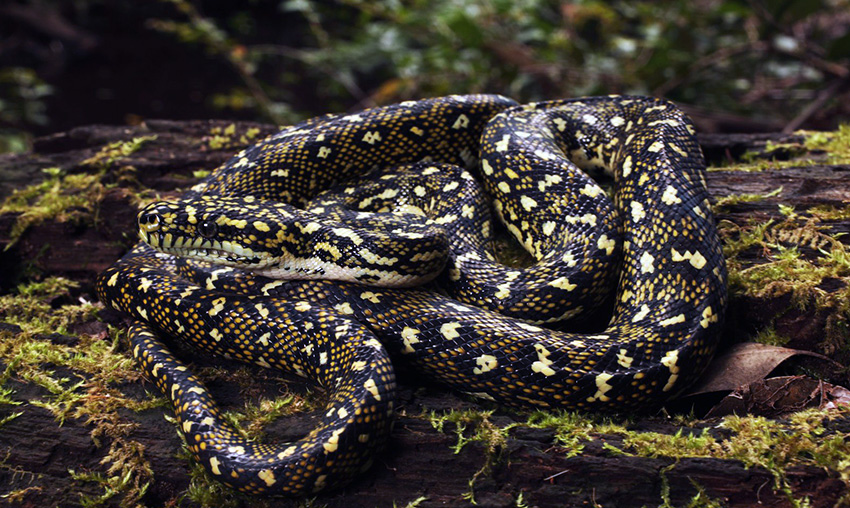
Harmless and non-venomous
A Diamond Python in your roof will not cause any damage but will help control rats and possums. Diamond pythons are predominantly black in colour with yellow spots arranged in diamond-like shapes. The average adult size is between 2m and 3m. Diamond pythons are typically placid in nature and reluctant to bite. They are mostly arboreal (tree-dwelling) but have been seen on roof-tops, curled up under trees or draped over fence-tops. They prey on rodents, lizards, birds and mammals such as possums. They are constrictors.
Habitat
The Diamond Python is found in large bushland areas and national parks of Sydney, but often goes undetected because of its nocturnal, slow-moving habits.
Distribution
The Diamond Python is found in coastal areas of New South Wales.
Feeding and diet
Like all pythons, the Diamond Python kills its prey by wrapping itself around its victim (in this case, small mammals and lizards) and suffocating it.
Other behaviours and adaptations
During the day, the Diamond Python may be seen basking in trees and occasionally it is found in roofs and rafters.
Life history cycle
The female Diamond Python lays eggs and coils around them to protect them and keep them warm. This maternal care, which is uncommon in snakes, ceases once the offspring hatch.
Conservation status
The Diamond Python is not as widespread in Sydney as it once was and, although it is not considered endangered, it is under pressure from habitat destruction.
Source: Australian Museum
-
Green Tree Snake - Dendrelaphis punctulata
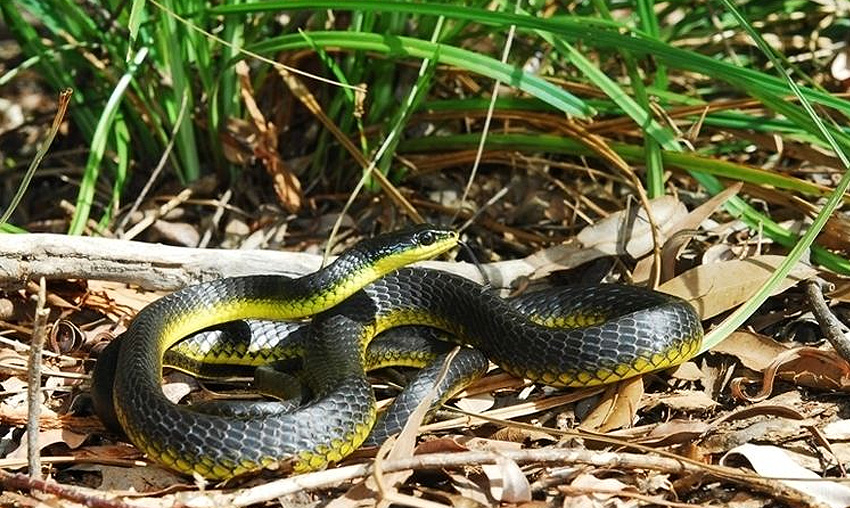
Harmless and non-venomous
The Green Tree Snake is very slender, is greenish-blue on the body and bright yellow on the belly. They have big black eyes and a very long, thin, prehensile tail. They reach lengths of around 1.2m. They are often seen on the ground which surprises people – given that they are tree snakes. They come to ground to prey on frogs, skinks and fish. Gorgeous little creatures!
The common tree snake, Dendrelaphis punctulatus, (also called green tree snake and Australian tree snake) is a slender, large-eyed, non-venomous, diurnal snake
This common snake is harmless, readily recognised as it is an agile snake with a very slender body and tail. The body colour varies from green to olive-green to black, sometimes even blue, frequently pale yellow on the throat and belly but other pale colours have been noted, blue flecks are present on the flank. Eyes are larger than in most snakes. Found in a variety of habitats ranging from rainforest to woodland to urban areas where it preys on fish, frogs and other small animals.
It has a primitive venom apparatus and a mildly toxic venom that is not regarded as dangerous to human beings. Its tiny grooved venom-conducting fangs are positioned to the back of the upper jaw, meaning that it must partially swallow its prey in order to work the fang’s toxin.
-
Golden-crowned Snake - Cacophis squamulosus
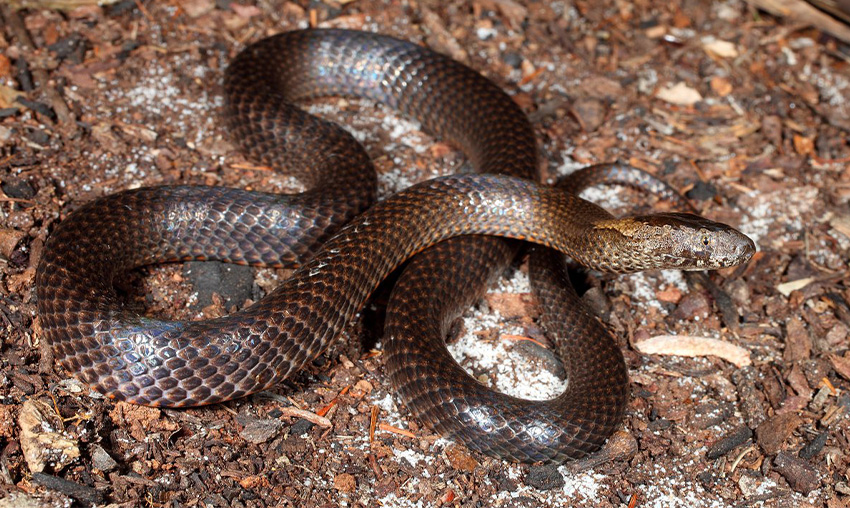
Mildly venomous – not considered dangerous. The Golden-crowned Snake is venomous, but not considered dangerous. When cornered, these snakes flatten their heads, arch the neck strongly and make a series of striking movements with a closed mouth, but rarely actually bite.
These little snakes are very secretive and are nocturnal so you’d be lucky to encounter one. They’re dark brown to grey in colour with a pink belly. They have a yellowish ‘halo’ or crown – hence their name. Golden-crowned snakes tend to reach lengths of between 50cm – 75cm. They feed predominantly on lizards and occasionally frogs. They are wonderful little snakes but they often get into trouble when cats pounce on them and bring them inside.
The Golden-crowned Snake is a small nocturnal, terrestrial species that is sometimes encountered on warm nights in suburban areas. Domestic cats may bring one inside and cause some alarm. However, it is not considered to be a dangerous snake.
Identification
The Golden-crowned Snake is brown to grey above and pink below, with a yellowish crown-shaped marking on the head which gives it its name. The pupils are vertically elliptical.
Habitat
The Golden-crowned Snake lives in deep forest and sandstone areas.
During the day, the Golden-crowned Snake shelters under stones, logs and leaf litter, emerging at night to feed.
Distribution
The Golden-crowned Snake is found on the east coast and adjacent ranges, from central New South Wales to south-eastern Queensland, preferring deep forest in the north of its range. In the south, it can be found in sandstone areas, being more common in the northern parts of Sydney.
A related species is the Dwarf Crowned Snake, Cacophis krefftii, which is much smaller (25 cm), with a dark-grey to black body and a cream to yellow hood over the nape of its neck. This species ranges from the central coast of New South Wales to south-eastern Queensland, and does not occur in Sydney.
Feeding and diet
The Golden-crowned Snake feeds at night. It searches for sleeping lizards by scent, taking them from their night-time retreats. It may also eat frogs and blind snakes.
Other behaviours and adaptations
The Golden-crowned Snake is nocturnal and very secretive.
Life history cycle
The Golden-crowned Snake reproduces by laying 2 – 15 eggs, with an average clutch of about six. The eggs are laid in January and hatch in March. Pregnant females have been observed lying on warm roads at night, possibly to assist in egg incubation. The young measure about 16 cm in total length at birth.
Source: Australian Museum
-
Red-bellied Black Snake - Pseudechis porphyriacus
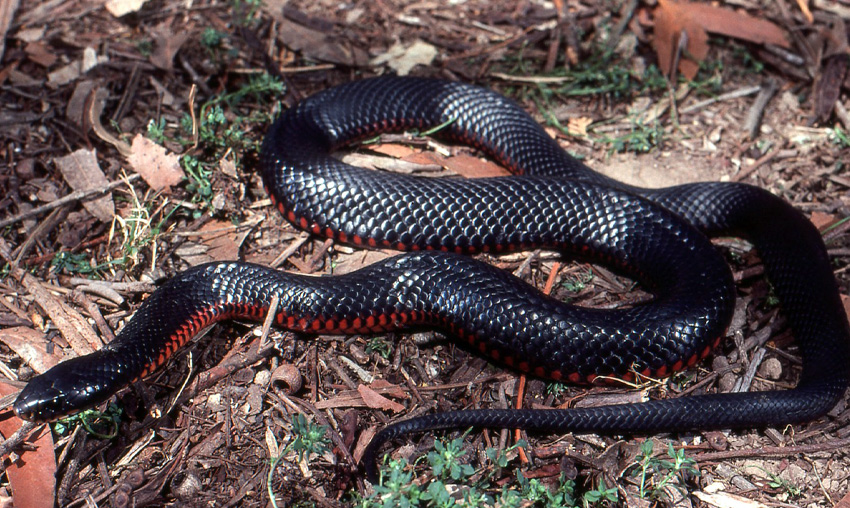
Venomous but very reluctant to bite or engage with humans or animals
This beautiful serpent shares our love of sunshine and water, and is a familiar sight to many outdoor adventurers in eastern Australia. Attitudes towards these largely inoffensive snakes are slowly changing, however they are still often seen as a dangerous menace and unjustly persecuted.
The Red-bellied Black Snake is a gorgeous glossy black on top and red on the lower sides and belly. The average-sized specimen is 1.2m – 1.5m. They are often found near water and are excellent swimmers! Their diet consists primarily of frogs. They are not an aggressive species and their first form of defence is always to escape. They are often just moving through your property and should just be left alone.
Seasonality
During the spring breeding season males actively search for females and consequently spend more time in the open and travel further than females generally do (up to 1220m in a single day). As the breeding season winds down males reduce their activity and by summer there is no significant difference between males and females in the amount of time spent in the open, either basking or moving, and both sexes bask less and become less active than they were in spring.
Feeding and diet
Red-bellied Black Snakes feed on a variety of vertebrates including fish, tadpoles, frogs, lizards, snakes (including its own species) and mammals. They search widely for prey on land and in water, and are known to climb to several metres. When hunting in water the snake may forage with only its head under or submerge itself fully. Prey captured under water may be taken to the surface or else swallowed while still submerged. Snakes have been observed deliberately stirring up underwater sediment as they hunt, presumably to flush out hidden prey.
Other behaviours and adaptations
In the wild, active Red-bellied Black Snakes maintain a body temperature in the range 28 to 31º C during the day by shuttling between sunny and shady spots. The rate of heating in the morning is more rapid than the rate of cooling in the evening, an indication of their ability to control their temperature by behavioural (e.g. shuttling, body posture) and/or physiological means (e.g. by regulating blood flow to different parts of the body). RBBS are primarily diurnal however they can remain active well into the late evening if temperature permits.
When fleeing a terrestrial predator, RBBS may enter water and stay submerged with just their head showing, or else dive under completely for as long as 23 minutes.
Life history cycle
Courtship and mating among wild Red-bellied Black Snakes occurs primarily in spring (early October to November). Males travel widely in search of receptive females and will engage in combat with any rival male that they encounter. Combat involves the two combatants spreading their necks and rearing up their forebodies, and hooking their necks around one another with a twisting motion that leads to the bodies becoming intertwined. After the initial engagement, they lie outstretched along the ground, but in some cases the forebodies remain raised. The object of the combat seems to be to push and hold the opponent down, and during the struggle the snakes may hiss and even bite each other (the biting is not serious as the snakes are largely immune to their species’ venom). In the wild, the bouts may last from only a few minutes for up to half and hour.
Red-bellied Black Snakes are the only species in the genus Pseudechis that have live young (the other species all being egg-layers), and this ability gives them an advantage in cooler climates by allowing the female to have greater control over the temperatures at which her young develop. Red-bellied Black Snakes reach sexual maturity in 2-3 years, although there is a record of one male that was mature at only 19 months of age.
Conservation status
Although the Red-bellied Black Snake is still relatively abundant in some areas, its strong association with riparian and wetland habitats makes it vulnerable to the draining and destructive management of these ecosystems. It has also proved vulnerable to the introduced Cane Toad, which is thought to have impacted heavily on its numbers in northern parts of its range.
Predators
The only recorded predators of adult RBBS, aside from humans, are feral cats, although presumably they would fall prey to other known ophidiophages, e.g. brown falcons and other raptors. Newborn and juvenile snakes face predation by smaller carnivorous birds, e.g. kookaburras, other snakes, frogs, and even invertebrates such as red-backed spiders.
Red-bellied Black Snake are susceptible to the toxin of Cane Toads (Bufo marinus), and rapidly die from ingesting or even just mouthing them. Their decline in parts of Queensland and northern NSW is thought to be due to the presence of toads, although there are signs that their numbers are recovering in some areas.
The species’ known endoparasites include acanthocephalans, cestodes (tape worms), nematodes (round worms), pentastomids (tongue worms) and trematodes (flukes).
Danger to humans
Red-bellied Black Snakes are one of the most frequently encountered snakes on the east coast of Australia, and are responsible for a number of bites every year. They are a shy snake and will generally only deliver a serious bite under severe molestation.
When approached in the wild a Red-bellied Black Snake will often freeze to avoid detection, and people may unknowingly get quite close before registering the snake’s presence. If approached too closely the snake will usually try to flee towards the nearest retreat, which if located behind the observer may give the impression the snake is launching an attack. If unable to escape the snake will rear up with its head and forebody held off but parallel to the ground, spread its neck and hiss loudly, and may even make mock strikes with a closed mouth. Some individuals will lay low and slowly undulate their tail in a fashion similar to many lizards, presumably to draw attention away from the vulnerable head. Further harassment will cause the snake to lash out and deliver a rapid (but often clumsy) bite, and sometimes they may hang on and chew savagely. The venom has predominantly anticoagulant and myotoxic effects, and symptoms of envenomation include bleeding and/or swelling at the bite site, nausea, vomiting, headache, abdominal pain, diarrhoea, sweating, local or general muscle pain and weakness, and red-brown urine (due to myoglobin being released from damaged muscle tissue).
For its size, the Red-Bellied Black Snake is probably the least dangerous elapid snake in Australia. Despite the number of bites received every year, very few human deaths have resulted (most death records date from early times and the snake’s identity was often unconfirmed). Many bite victims experience only mild or negligible symptoms, however a number also end up hospitalized. The health risks to children and pets are greater, due to their smaller size. As individual reactions to envenomation can vary, all suspected bites should be treated as serious and medical attention sought as soon as possible.
Source: Australian Museum
-
Eastern Brown (Common Brown) Snake - Pseudonaja textilis
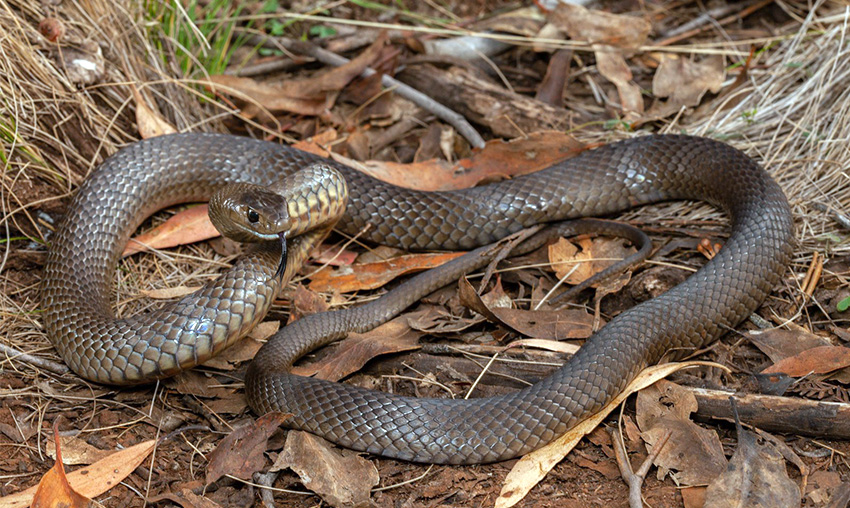
A slender snake extremely venomous and aggressive when threatened or cornered with bullet shaped head.
These snakes can grow up to and beyond 2 metres and are usually pale brown to grey in colour. Juvenile Browns usually have bands down their body and can often be confused for a Tiger Snake. They are found in grass/woodlands but do tend to pass through backyards, sheds and houses (usually due to habitat destruction) in search of food and shelter. Females can lay up to 35 eggs and a number of females can reuse the same nest. Diet: Mainly feeds on small mammals but will also take birds, reptiles and frogs.
Identification
A medium sized snake, with a slender to moderate build and a smallish head barely distinct from the neck. Body colour may be almost any shade of brown, ranging from near black to light tan, chestnut or burnt-orange. The head colour of dark individuals may be slightly paler than the rest of the body, but otherwise the dorsal colour is fairly uniform (a very few scattered dark scales may be present). Hatchlings have a prominent dark patch on the top of the head and across the nape, and some hatchlings also have dark bands down the entire length of the body. These markings fade as they mature, however in some populations the bands are retained into adulthood.
Unrelated species similar to the Eastern Brown include the Mulga Snake (Pseudechis australis) and Taipan (Oxyuranus scutellatus).
Habitat
Eastern Brown Snakes can be found across a wide range of habitats (excluding rainforest and alpine regions), however they seem to prefer open landscapes such as woodlands, scrublands, and savannah grasslands. In arid inland areas they inhabit watercourses and swampy areas that receive at least some seasonal flooding.
Distribution
The species is widespread throughout eastern Australia, from northern Queensland to South Australia, with isolated population occurring in central and western Northern Territory.
Seasonality
Along a standard transect in central southern New South Wales, Eastern Brown Snakes were encountered at the highest rate in spring, followed by autumn and summer/winter. They can be found active on mild winter days and have been observed basking in air temperatures as low as 14º C. Males usually become active earlier in the season than do females (in spring, most road-killed snakes are males).
Feeding and diet
In the wild, Eastern Brown Snakes eat a variety of vertebrates, including frogs, reptiles and reptile eggs, birds and mammals, particularly introduced rats and mice. Smaller snakes, up to a snout-vent length of about 70 mm, eat proportionally more ectothermic prey, such as lizards, while larger snakes tend to consume more warm-blooded prey.
Brown snakes hunt by actively looking for prey and searching in likely hiding places. They have good eyesight and once prey is detected they will give chase and subdue the prey using both venom and constriction. Eastern Browns are mainly hunt during the day however during very hot weather they may delay foraging until late in the afternoon / early evening.
Breeding behaviours
Breeding activity for Eastern Brown Snakes begins in mid to late spring. In the wild, males have been observed engaging in ritual combat for access to receptive females. The combating snakes intertwine tightly and wrestle for up to half an hour or more, with each snake trying to push down and overpower the other.
Females can lay up to 25 eggs (15 on average) in a clutch, Under favourable conditions females may be able to lay several clutches in one season.
Conservation status
Given that the Eastern Brown Snake will readily inhabit areas disturbed by human activity and predate on an abundant, exotic food source (house mice), its future seems assured.
Predators
The species’ known predators include birds of prey and feral cats. They appear to have immunity to the venom of a would-be predator, the Mulga Snake (Pseudechis australis), as well as their own species (one snake that had been swallowed by another Eastern Brown was regurgitated an hour later, apparently not too much worse for wear). However they are not so fortunate with the effects of cane toad venom and rapidly die from ingesting them.
Countless brown snakes fall victim to road vehicles every year (both accidentally and on purpose), while many others are killed on sight by landowners.
Danger to humans
This species has the unfortunate distinction of causing more deaths from snake bite than any other species of snake in Australia. Many bites have been a direct result of people trying to kill these snakes and could obviously have been avoided. Simple precautions, such as wearing long pants, thick socks and solid footware when working or exploring outdoors greatly reduces the risk of being envenomated should there be a close encounter with a startled snake. As the initial bite is generally painless and often difficult to detect, anyone suspected of receiving a bite from an Eastern Brown Snake should call for medical attention without delay.
This species is probably encountered more than any other type of snake. Being an alert, nervous species they often react defensively if surprised or cornered, putting on a fierce display and striking with little hesitation. However, if approached over a distance, they will usually choose to flee or else remain stationary, hoping to avoid detection. The approach distance tolerated before the snake flees is temperature dependent – snakes with a body temperature of < 24º C allow significantly closer approach than do snakes with a body temperature > 24º C. When confronted by an intruder, the Eastern Brown displays one of two forms of threat. In the mild threat, the snake raises the head and anterior part of the body slightly off and parallel to the ground, with the neck spread laterally and slightly hooked but the mouth closed. In this posture, the snake faces the threat side on. If issuing a strong threat, the snake raises the anterior part of the body well off the ground in an s-shaped coil and with the mouth slightly open, ready to strike – in this posture, the snake faces the threat more squarely. Strikes delivered from this posture are slower but more accurate that strikes delivered from other postures. The common feature of both displays is the spreading of the neck, and this behaviour precedes most bites.
Relative to other similar-sized elapids the fangs of the Eastern Brown are quite small (around 3mm), as is the average venom yield (around 4mg, although the record venom yield was 67mg). However what the snake lacks in venom delivery it makes up for in potency. The venom contains powerful presynaptic neurotoxins, procoagulants, cardiotoxins and nephrotoxins, and successful envenomation can result in progressive paralysis and uncontrollable bleeding. Occasional fatalities have occurred as a result of bleeding into the brain due to coagulation disturbances.
Source: Australian Museum
-
Eastern Tiger Snake - Notechis scutatus
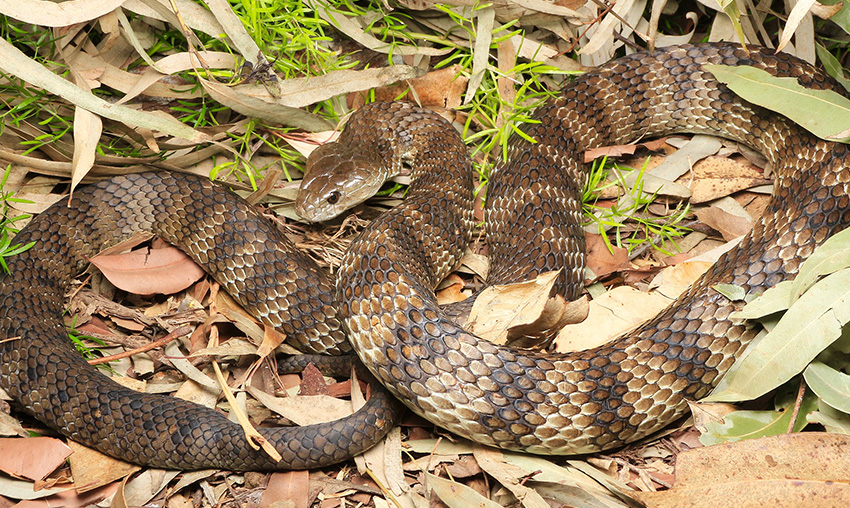
Most Australians know of tiger snakes and are aware of their fearsome reputation, though few people will ever encounter one. Unfortunately this species is much maligned because of its aggressive nature and toxic venom; however the tiger snake should be recognised as a great survivor, superbly adapted to some of the most inhospitable environments in Australia.
This is a highly venomous snake which can grow to 1.2 metres and comes in a variety of colours from brown, olive grey to jet black. The most common colouring around Sydney is light grey to blueish with darker grey bands running down the entire body with a creamy underbelly. The Eastern Tiger Snake has a broad habitat; ranging from rainforests to dry areas and even river flood plains. Female gives birth to between 20 and 30 live young. Diet: Mainly feeds on frogs but is not fussy and will also take small mammals and reptiles.
Habitat
The species is often associated with watery environments such as creeks, dams, drains, lagoons, wetlands and swamps. They can also occur in highly degraded areas e.g. grazing lands, especially where there is water and local cover. Tiger snakes will shelter in or under fallen timber, in deep matted vegetation and in disused animal burrows. Unlike most other Australian elapids, tiger snakes climb well on both vegetation and human constructions, and have been found as high as 10 m above the ground.
Seasonality
Snakes are typically more active during the warmer months, however tiger snakes may also be found out basking on warm winter days. During cool periods they will aestivate in animal burrows, under large boulders and in standing dead trees, and may go as deep as 1.2m underground. As many as 26 neonates, perhaps all from one late season litter, have been found together in a winter shelter.
Feeding and diet
Tiger snakes in the wild have a broad diet that includes fish, frogs and tadpoles, lizards, birds and mammals, as well as carrion. As the size of the snake increases, so to does the average prey size, however this increase is achieved not by larger snakes giving up on small prey but by them taking more large prey. Tiger snakes are largely diurnal and hunt for prey during the daylight hours; however they will forage on warm evenings. They will readily search underwater and can stay under for at least 9 minutes. A bat was found in the stomach of one museum specimen, demonstrating the tiger snake’s ability to climb. Invertebrates have also been found in tiger snake stomachs however these could have been taken as part of carrion; other taxa such as grasshoppers and moths however may have been ingested as prey. Cannibalism amongst wild tiger snakes has also been reported. Prey items are grasped and subdued quickly by the powerful venom, with sometimes constriction being employed as well.
Available prey size is thought to play an important role in dictating the adult size of tiger snakes in some island populations. For example, on Chappell Island the snakes are typically very large and take advantage of the seasonal abundance of fat muttonbird chicks, whereas on Roxby Island where there are no nesting seabirds the dwarf population of snakes survive on mostly small skinks.
Predators
The known predators of tiger snakes include the elapid snake Cryptophis nigrescensand certain birds of prey such as butcherbirds, goshawks, harriers, ibises, kites and kookaburras. In one survey taken on Carnac Island, a high proportion of the tiger snakes were blind in one (6.7 percent) or both eyes (7.0 percent) due the attacks by nesting gulls. While this is not predation per se, it does increase the catchability of the snakes by human hunters and hence probably increases the chances of their being taken by non-human predators. Tiger snakes have also been heavily persecuted by humans in the past and are still routinely killed when encountered. Many also become road victims.
Tiger snake are known to be parasitized by ticks, cestodes (tape worms), nematodes (round worms), pentastomids (tongue worms), and trematodes (flukes).
Danger to humans
The snake’s large size, often aggressive defence and toxic venom make it extremely dangerous to humans. Although generally shy and preferring escape over conflict, a cornered tiger snake will put on an impressive threat display by holding its forebody in a tense, loose curve with the head slightly raised and pointed at the offender. It will hiss loudly as it inflates and deflates its body, and if provoked further will lash out and bite forcefully. The venom of the tiger snake is strongly neurotoxic and coagulant, and anyone suspected of being bitten should seek medical attention immediately.
Source: Australian Museum
-
Death Adder - Acanthophis antarcticus
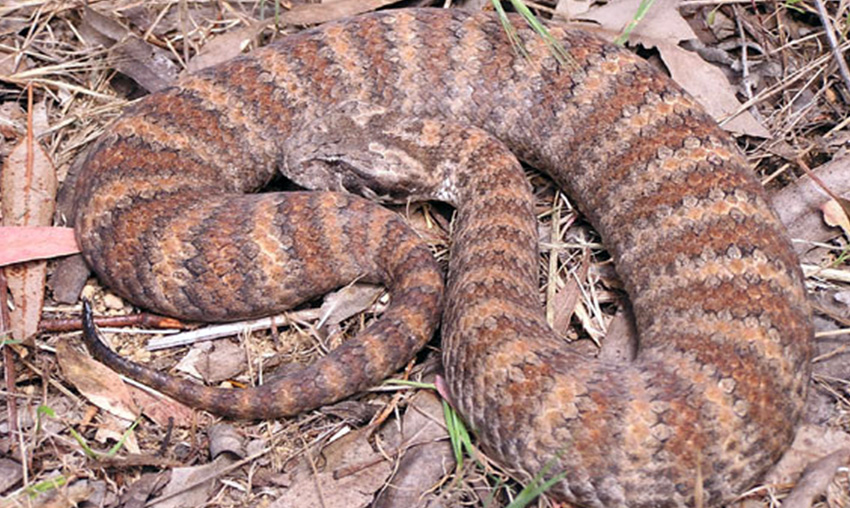
There are several species of death adders in Australia but the Common Death Adder is the only one found in the Sydney region.
This is an extremely venomous and dangerous snake due not only to its potent venom but also its camouflage and incredibly fast strike. With larger fangs than most venomous snakes in Australia, this is a relatively short and fat snake that comes in a variety of banded colours ranging from; red, grey to multicoloured stripes in Northern Australia. Death Adders can grow from 70 to 100 cm but are usually found around 30 to 60cm. These snakes live in a variety of different habitats including forests, woodlands and grasslands where it blends in perfectly with loose leaf litter. Being an ambush predator it hides in loose leaf litter or sand/dirt using its tail as a lure to attract prey. Females give birth to up to 20 live young. Diet: Feeds mainly on birds but would take small mammals.
The common death adder is an ambush predator that sits motionless, concealed in leaf litter, sand or gravel, twitching the worm-like lure on the end of its tail to attract prey.
Unlike other snakes that flee from approaching humans crashing through the undergrowth, common death adders are more likely to sit tight and risk being stepped on, making them more dangerous to the unwary bushwalker. They are said to be reluctant to bite unless actually touched.
About half of death adder bites proved fatal before the introduction of antivenom. The venom contains a type of neurotoxin which causes loss of motor and sensory function, including respiration, resulting in paralysis and death.
Identification
The Common Death Adder is easily recognised by its triangular-shaped head, short stout body and thin tail.
Habitat
The Common Death Adder lives in forests and woodlands, grasslands and heath.
Feeding and diet
The Common Death Adder feeds on frogs, lizards and birds and, unlike most Australian venomous snakes that actively search for prey, this snake sits in one place and waits for prey to come to it. Covering itself with leaves makes it inconspicuous and it lies coiled in ambush, twitching its yellowish grub-like tail close to its head as a lure. When an animal approaches to investigate the movement, the death adder quickly strikes, injecting its venom and then waiting for the victim to die before eating it.
Life history cycle
The Common Death Adder may give birth to up to 24 live young.
-
Mulga snake (King Brown) - Pseudechis australis
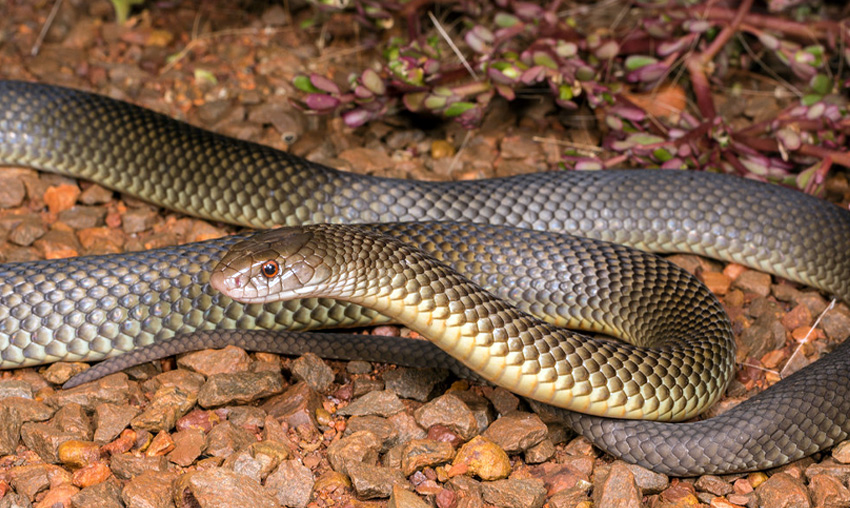
Found: throughout Australia, except in Victoria, Tasmania and the most southern parts of Western Australia – the widest distribution of any Australian snake. The mulga is the heaviest venomous snake in Australia and has the largest-recorded venom output of any in the world – delivering 150mg in one bite; the average tiger snake only produces 10-40mg when milked.
Their temperament seems to vary with locality. Southern mulgas are reported to be shy and quiet, whereas northern specimens are much more agitated if disturbed – when they throw their heads from side to side and hiss loudly. Mulgas bite savagely, even hanging on and chewing as they inject massive amounts of highly toxic venom, which destroys blood cells and affects the muscles and nerves.
Though commonly known as a king brown snake, the mulga is actually a member of the black snake genus Pseudechis, and black snake antivenom is needed to treat a bite.
Habitat
They shelter in disused animal burrows, in deep soil cracks, under fallen timber and large rocks, and in deep crevices and rock cavities in outcrops.
Seasonality
Southern specimens that are typically darker coloured have been observed basking in winter.
Feeding and Diet
In the wild, Mulga Snakes feed on a wide variety of vertebrate prey, including frogs, reptiles, reptile eggs, bird eggs, birds and mammals. The species also occasionally eats invertebrates and carrion.
Mulga Snakes are apparently immune to the venom of at least one of their snake prey, the Western Brown Snake Pseudonaja nuchalis, and show no ill-effects when bitten by their own species. Unfortunately the Mulga Snake is not immune to the toxic Cane Toad, which is thought to have led to the snake’s decline in some northern parts of its range.
Other behaviours and adaptations
The species may be active both during the day and night (according to temperature), with diminished activity during mid-day and between midnight to dawn. During the hottest months, particularly in the northern parts of their range, Mulga Snakes become most active in the late evening and early hours after dusk.
Life cycle
Male combat has been recording in early-mid spring for this species. The males entwine their bodies and with their raised heads attempt to push over their opponent.
In southwestern Australia, mating has been recorded in early spring, and in Eyre Peninsula in mid-spring. In a survey of specimens in all the major Australian museums, females with yolking follicles had been collected between mid-winter and late spring, and females carrying oviducal eggs were from mid-summer, mid- autumn and early spring. In northern populations breeding may be aseasonal or associated with the wet and post-wet season. The time between the last courtship/mating and egg-laying varies from 39 to 42 days. Clutch sizes range from 4 to 19, with an average of around 9. There is a significant positive relationship between the snout-vent length of the female and clutch size.
The eggs may take between 70 and 100 days to hatch, depending on the incubation temperature. There has been a case where two hatchlings emerged from one egg – the egg was normal sized but the hatchlings were about half the size of their clutch mates.
Predators, Parasites and Diseases
Large Mulga Snakes have few enemies, however small specimens may fall victim to birds of prey.
The species’ known endoparasites include nematodes. Older specimens often carry a high burden of ticks.
Conservation Status
Not listed as threatened.
Danger to humans and first aid
When threatened, the Mulga Snake inflates its body and holds its head and flattened neck in a wide curve parallel to the ground. It will throw its head and neck from side to side, hissing loudly as it does. If pressed further it will lash out wildly in an attempt to bite. Mulga Snakes bite savagely and may hang on and chew as they inject their venom. The venom is highly toxic and can be expressed in enormous quantities. Its effects are mainly haemolytic (breaks down blood cells), cytotoxic (disrupts cells), myotoxic (affects muscle), and also mildly neurotoxic (affects nerve cells).
Anyone suspected of being bitten should seek immediate medical attention. Should antivenom be required it is important to note that despite the alternative common name of King Brown Snake, the Mulga Snake is in fact a member of the black snake genus Pseudechis, therefore Black Snake Antivenom will be necessary.